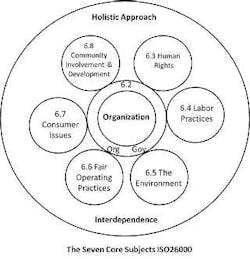The construction industry dramatically impacts the environment, with buildings consuming 17 percent of the world’s fresh water, 25 percent of its wood harvest, and 40 percent of its material and energy flows.
For years, the construction industry has practiced social responsibility by focusing on sustainable buildings in the commercial and residential sectors that incorporate renewable energy sources, energy-saving methods, water efficiency, improved indoor air quality and the reduction of CO2 emissions.
The focus goes beyond energy to include runoff and erosion control, as well as recycling of concrete, vinyl, wood, asphalt, glass and drywall.
Best Practices Support Design and Construction
Today, the industry is widening its view of social responsibility to include health, safety and environmental management, and it has adopted International Organization for Standardization (ISO) management standards such as ISO14001 (environmental), OHSAS18001 (safety) and ISO9001 (quality) to help drive performance improvement in the design and construction process.
The goal is to create an integrated quality, environmental, health and safety management system that improves the organization’s bottom line. Systems integration also can reduce risk, eliminate conflicting responsibilities, increase consistency and improve communication—all of which lead to improved strategic performance.
The management standards can integrate the various roles of project stakeholders such as engineers, architects, builders, contractors and clients/owners to improve small and large building projects in commercial, government and residential sectors across the country.
The Next Opportunity for a Competitive Edge
In November 2010, ISO released a voluntary guidance document, ISO26000, explaining how social responsibility can be made operational through measurement and monitoring of performance improvements. It includes common terminology and is consistent with international treaties and other ISO standards; it also applies to all organization sizes and sectors in any country.
ISO26000 focuses on seven aspects:
- Organizational governance: the system for decision-making and implementation.
- Human rights: civil, political, economic, social and cultural rights.
- Labor practices: work policies and practices.
- Environment: decisions, activities and implications regarding energy and natural resources.
- Fair operating practices: ethical business conduct.
- Consumer issues: use of fair and transparent information affecting consumers.
- Community development: relationships between the organization and other organizations, institutions and the community.
ISO26000 takes a big picture approach. For example, contractors should consider buildings not just from a design and construction or maintenance and upgrading perspective, but also through the decommissioning phase. Contractors should focus on the people who live in the built environments and all stakeholders involved in the community surrounding the building.
Driving Performance through Green
A more efficiently coordinated team and a better bottom line ultimately can result from using integrated management systems to create environmental stewardship.
As construction industry leaders build more sustainability into their organizations, they should consider the following checklist:
- Review current employee satisfaction scores and how they relate to industry and competitor benchmarks.
- Understand how client satisfaction scores and the satisfaction scores of those occupying the building relate to industry and competitor benchmarks, especially with regard to sustainability.
- Determine construction waste costs.
- Look at what percentage of total construction waste is recycled and what remaining waste can be recycled. Calculate the potential cost savings.
- Consider the community’s perceptions of the company and the building.
- Identify environmental impacts before, during and after construction.
- Identify and categorize project risks, and determine what risk mitigation plans are in place.
- Review opportunities for improving design-build cycle time.
Examining these areas and reviewing and how sustainability is currently integrated and measured should be a crucial part of developing sustainability.
For more information on the ISO standard, visit
About the Author

Denis Leonard
Denis Leonard has a degree in construction engineering, and an M.B.A. and a Ph.D. in quality management. He is a Fellow of the American Society for Quality and has been an Examiner for the Baldrige National Quality Award Board of Examiners, a Judge on the International Team Excellence Competition, and a Lead Judge on the National Housing Quality Award. He has experience as a quality manager in the home building industry as well as construction engineer, site manager, and in training, auditing, and consulting with expertise in strategic and operational quality improvement initiatives. His work has achieved national quality, environmental, and safety management awards for clients.
